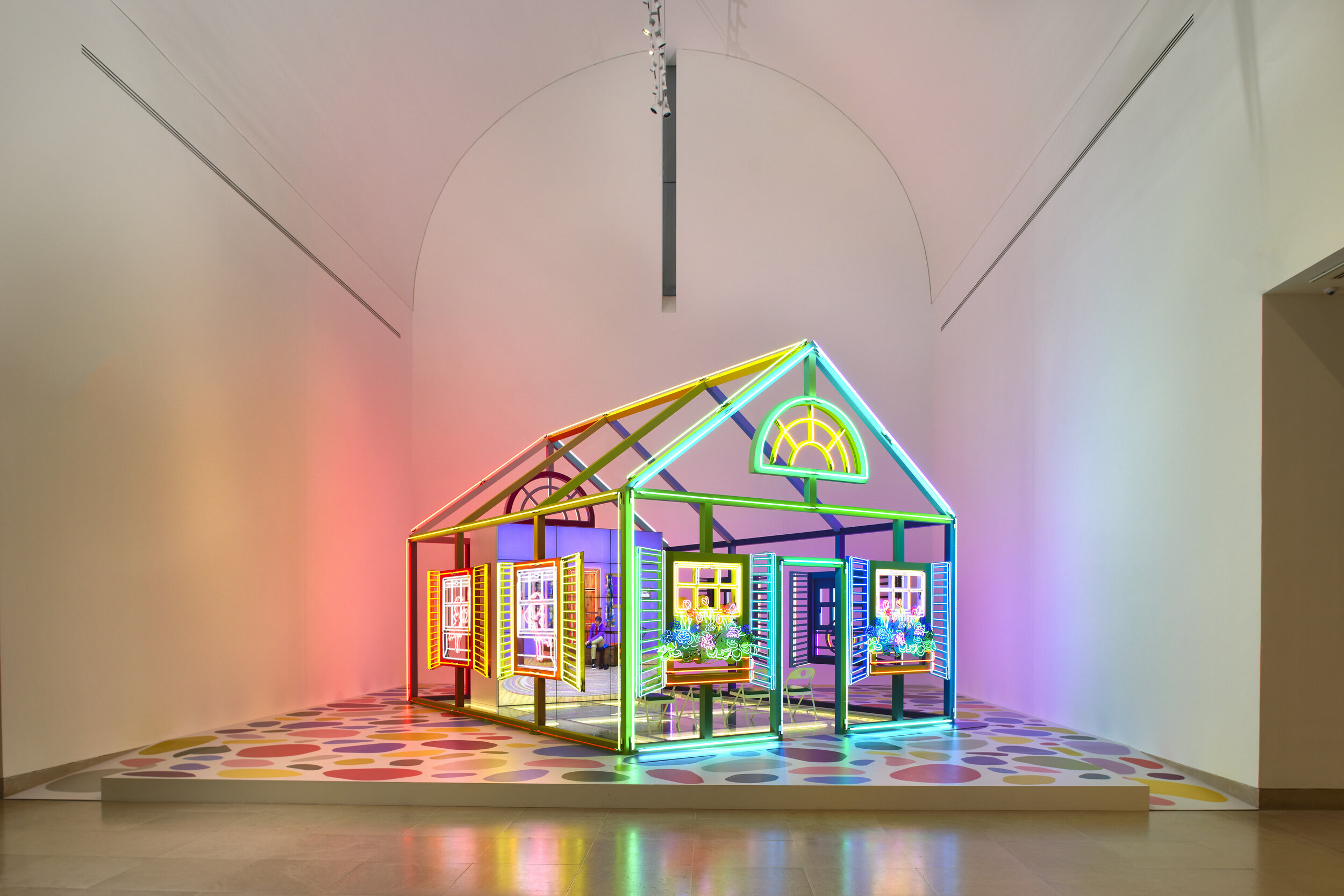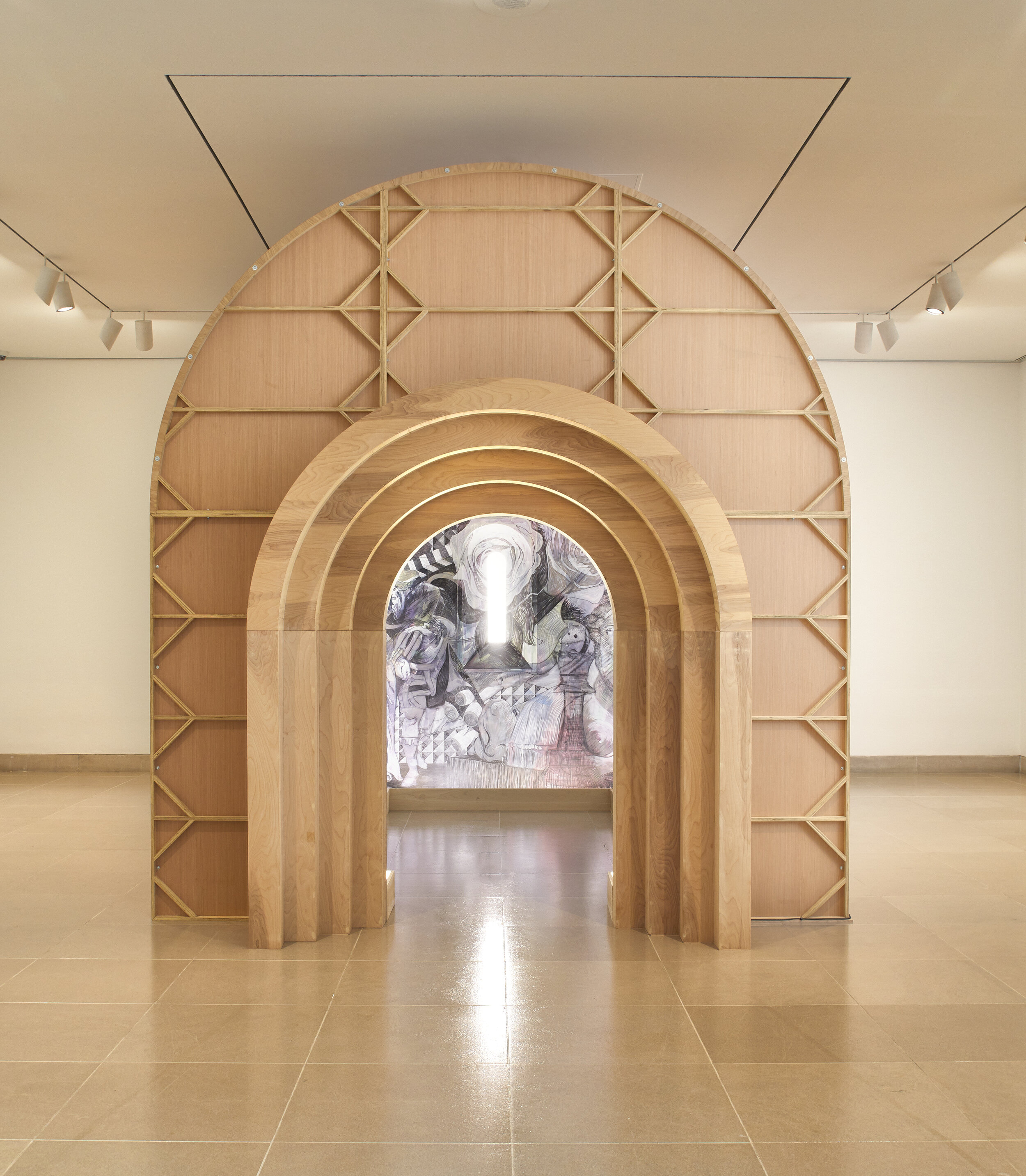For a Dreamer of Houses: Thinking About Home in Public
Alex Da Corte, Rubber Pencil Devil, 2018, Dallas Museum of Art. Photo by John Smith
By Kate Mazade
For over a year now, we’ve been at home. We go to work at the kitchen table. We eat our meals on the back porch. We visit our friends from the couch.
We’ve spent the last year staring at the four walls that enclose us, and for me, I’ve never been quite so grateful or so resentful of these walls. The Dallas Museum of Art’s contemplative exhibition For a Dreamer of Houses seems to get that.
The exhibition was set to open March 15, 2020, but just one day before the opening, the pandemic forced the DMA to close its doors and send those who dreamt of houses back to theirs. The exhibition’s fifty-four works—an assortment of media from the DMA’s permanent collection—weren’t confined quite as long as we were. The museum reopened with limited hours and capacity just five months into the pandemic.
Maybe it was a sneaking premonition or a bit of ironic foresight that this exhibition was planned for 2020. For a Dreamer of Houses became the epitome of timeliness, considering the many hours we’ve spent at home. It probes the comfort and frustration, the modification and adaptation, the freedom and confinement we experience in our homes. Curated by Dr. Anna Katherine Brodbeck, the Hoffman Family Senior Curator of Contemporary Art, the exhibition brings mid-century domestic philosophy into current day, exploring the concept of home through a socially- and culturally-progressive eye.
With works by thirty-five artists from around the globe, the collection was inspired by The Poetics of Space, an influential 1958 book by philosopher Gaston Bachelard that uses the house as a representation for both culture and psyche. The five galleries of the exhibition follow chapters selected from Bachelard’s book: “Nests,” “Shells,” “Dialectics of Inside and Outside,” “Drawers, Chests and Wardrobes,” and “Intimate Immensity,” each exploring a different spatial concept of home and the emotions it encapsulates.
Francisco Moreno, Chapel, 2016-18, Dallas Museum of Art. Photo by John Smith
Starting with early childhood experiences, the “Nests” gallery investigates home as a sanctuary for expression and an environment that blends reality and dream. Francisco Moreno’s “Chapel,” an all-encompassing wooden structure, creates a portal into its pencil and charcoal world that combines haunting Baroque and Romanesque motifs with monster trucks portrayed in pastel colors. The “Chapel” is paired with childlike refrigerator-taped drawings and family photographs, positing that a house becomes a home through its associated emotions.
Do Ho Suh, Hub, 260-10 Sungbook-dong, Sungbook-ku, Seoul, Korea, 2016, Dallas Museum of Art. Photo by John Smith
While walking through the “Shells” gallery, the lyrics of Miranda Lambert’s “The House that Built Me” began to circle inside my head. The photographs of vernacular houses with their familiar landmarks—the ivy covered tree by the swing, the trashcan waiting by the backdoor, the neighbor's backyard slide peaking just over the fence—become the touchstones and boundaries of our lives. Do Ho Suh’s “Hub, 260-10 Sungbook-dong, Sundbook-ku, Seoul, Korea” stretches gossamer teal fabric over a space frame, recreating a transitory version of a porch-like passageway from the artist’s childhood home. The pieces in the “Shells” gallery consider how layers of material and understood boundaries create a sense of protection—and with a few cultural clues and identifiers, create a sense of place.
Alex Da Corte, Rubber Pencil Devil, 2018, Dallas Museum of Art. Photo by John Smith
In the echoing barrel vault, the “Dialectics of Inside and Outside” section holds the exhibition’s centerpiece, an investigation of how the residential forms that bring us comfort in their familiarity too often get distorted and take on more meanings than we originally thought. Alex Da Corte’s “Rubber Pencil Devil” is a glowing incongruity. The neon-lit house combines Mr. Rogers Neighborhood with Robert Venturi’s Ghost House. The exterior glows with commercialized holiday decorations, while the interior plays 57 Technicolor video segments on 15 glaring screens. Almost impossible to look away from, the piece hypnotizes visitors with the perversion of home by visual culture.
Sarah Lucas, ICON, 2006, Dallas Museum of Art. Photo by John Smith
But the multicolored glow fades quickly to the everyday in the “Drawers, Chests, and Wardrobes” gallery. The nostalgic furniture-based works represent the baser emotions we experience within our homes, passed down like heirlooms. Doris Salcedo’s “Untitled” cement-filled wardrobes lock away pain and grief, while Sarah Lucas’s “ICON” sculpture, a pair of stuffed tights splayed over a chair, contort desire with absurdity.
For a Dreamer of Houses at the Dallas Museum of Art, Intimate Immensity. Photo by John Smith
The exhibition’s fifth gallery, “Intimate Immensity,” presents the final juxtaposition: the soft, vulnerable homes of the clothes that we wear to shield us from the vastness of the world. Pipilotti Rist’s “Massachusetts Chandelier” suspends underwear in a collective human celebration, and Janine Antoni’s “Grope” sculpture pulls pants pockets from where they were privately pressed against thighs and airs them out in public.
For a Dreamer of Houses is a contradiction. From the sound—Dolly Parton’s “Light of a Clear Blue Morning” blaring through the central cavernous space compared to the dampened footsteps in the smaller galleries—to the texture and grain of the artwork—ranging from precise drawings and delicate photographs to chucky clay sculptures and entrancing light shows. The exhibition balances home with homemade and belongings with belonging.
The timing of this exhibition is paramount, not just for the amount of time we’ve spent at home this year, but for the contradictions our homes have become.
_______________________
For a Dreamer of Houses is on display at the Dallas Museum of Art through July 4, 2021. Reserve in-person tickets at DMA.org, or explore the free virtual tour at virtual.dma.org.





